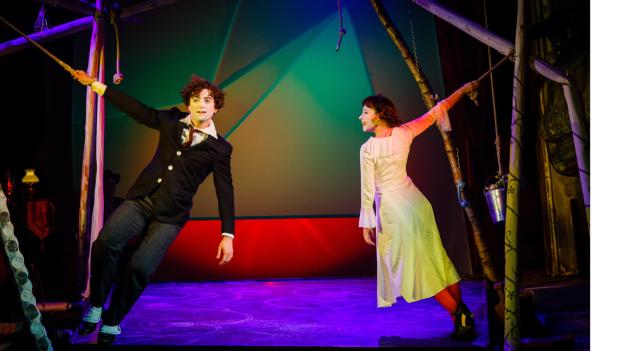Britain’s Kneehigh theatre company is back for its third Beverly Hills foray at the Wallis Annenberg Center for the Performing Arts, presenting an impressionistic bio-play about Russian Jewish painter Marc Chagall (Marc Antolin) and writer Bella Rosenfeld (Daisy Maywood). They are the eponymous couple depicted in playwright Daniel Jamieson’s two-character The Flying Lovers of Vitebsk. Unlike director Emma Rice’s two previous Kneehigh Productions at the Wallis, Noël Coward’s Brief Encounter and 946: The Amazing Story of Adolphus Tips, Lovers is much less full-throated and ambitious.
The play endeavors to tell the love story of Marc and Bella not only through the actors, but with live klezmer and other types of music performed by Ian Ross and James Gow, plus via visuals derived from Chagall’s rich, whimsical imagery. Unfortunately, unlike Brief and 946, Sophia Clist’s set is not particularly inspired and considering the archive of artistry they had to work with, the renditions for the stagecraft of Chagall’s pictorial panache didn’t sweep me off my feet either. In terms of design, props, etc., there seems to have been a failure of imagination, especially given the sense of whimsy and fantasy that Chagall injected into his original canvases, infused with constructivist, cubist and expressionist techniques.
The optical aside, Lovers works better on other levels. A spats-wearing Antolin and Maywood sometimes evince a silent cinema slapstick style while incarnating the title characters. They are swept up by the tumultuous events of the 20th century rocking their town in Belarus that has a large Jewish population. Chagall’s interactions with the Russian Revolution are recounted here - according to the bio-play, he was offered the position as the new Soviet Union’s commissar of art, while Meyerhold and Mayakovsky were offered the posts of theatre and poetry commissars. Instead, Chagall chose something closer to home and perhaps less political in the propagandistic sense, as commissar of arts for Vitebsk, which led to the creation of the acclaimed Vitebsk Arts College.
But Chagall became enmeshed in Soviet faction fights, and as Stalinism began to emerge, was fired from the school he’d founded as the Suprematist abstract painter Malevich took over. The Chagalls moved to Moscow and Bella, who had studied with Stanislavski, became involved with the State Jewish Chamber Theater, while Marc became its stage designer and created landmark murals for it. Conditions in the USSR following years of Revolution, civil war, imperialist invasion and famine were extremely harsh and the Chagalls eventually emigrated to France in 1923, where they lived until Nazism unleashed additional shockwaves and the exiles relocated to New York, et al.
Lovers also portrays the monomania of the artist, who puts his/her art and the need to create before everything - and everyone - else, which exacts a price on relationships. Chagall, who lived to be almost 100, was to painting what Sholem Aleichem was to the page - capturing the essence of shtetl life of Eastern European Jews for all time. This is heady, heavy stuff, but the play’s lackluster replication of the painter’s work and lack of inspired special effects hamper a full realization of a vision of Marc and Bella’s lives on the stage. These lovers leap but do not soar.
The Flying Lovers of Vitebsk is being performed Tuesdays through Sundays at 7:30 p.m., and at 2:00 p.m. on Saturdays and through March 11 in the Bram Goldsmith Theater, Wallis Annenberg Center for the Performing Arts, 9390 N. Santa Monica Blvd., Beverly Hills, CA 90210. For info: (310)746-4000; www.thewaillis.org/lovers .
The third edition of “The Hawaii Movie and Television Book”, co-authored by L.A.-based film historian/reviewer Ed Rampell, drops in March, 2018.

